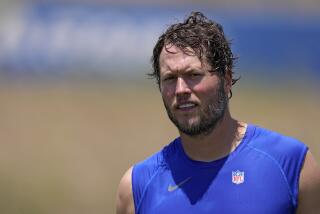Heatstroke Death Shakes NFL Teams
- Share via
The Minnesota Vikings and the rest of the National Football League were shocked Wednesday by the heatstroke death of a star offensive lineman after the team’s first two days of workouts.
The death of Korey Stringer, 27, a 335-pound All-Pro tackle, was the first heatstroke death in league history. It placed a disturbing spotlight on the grueling regimen that professional, college and high school football players go through in preseason camps.
NFL Commissioner Paul Tagliabue immediately called on all 31 teams to review their procedures in training camp, where breaks for rest and water are often seen as signs of weakness in a testosterone-fueled culture.
Stringer had first experienced difficulties during Monday’s practice, held in 90-degree heat at the team’s practice facility in Mankato, Minn. He vomited and shortly afterward was assisted off the field.
He practiced again Tuesday but vomited at least three more times as the temperature rose to 91 on the hottest day of the year in Mankato. High humidity made it seem even warmer: The “heat index” was 110 degrees. Stringer had the wind knocked out of him during one drill. He dropped to a knee after practice and retreated to an air-conditioned trailer, suffering from the symptoms of heatstroke.
Stringer was taken to a hospital and was unconscious upon arrival. His body temperature had risen to 108 degrees. He never regained consciousness before being pronounced dead early Wednesday.
Viking camp doctor David Knowles said Stringer suffered damage to his vital organs, developed a bleeding disorder and suffered kidney failure and then heart failure.
Heatstroke deaths are rare but not unknown in football at all levels, according to a study by the University of North Carolina Department of Exercise and Sports Science. The report, funded by the NCAA and National Federation of State High School Assns., said two high school and two college football players died of heatstroke last year. There have been 103 such deaths since 1960.
Last week, Eraste Autin, a freshman running back at the University of Florida, died of heatstroke complications six days after collapsing and falling into a coma following a July 20 workout.
Hours after Stringer died Wednesday, a 17-year-old high school player from Indiana, Travis Stowers, died of a brain aneurysm. He had collapsed during practice two days earlier. Officials said the heat was not a factor in Stowers’ death.
The Vikings refused to answer questions about the team’s handling of practice sessions or how Stringer was treated during the drills.
“I know everyone’s going to talk about the heat,” said one of Stringer’s teammates, receiver Cris Carter. “It’s hot everywhere. That’s why they call it the dog days of summer.”
The entire Midwest has been hit by oppressive heat. In Wisconsin, Chicago Bears Coach Dick Jauron canceled Wednesday afternoon’s practice because of the heat and humidity, although he said it was not a direct response to Stringer’s death.
Nevertheless, league officials were taken aback by the player’s death. Teams held moments of silence Wednesday in Stringer’s memory.
“When this happens, it should cause everybody to wake up,” Cleveland Browns President Carmen Policy said.
At their Westminster, Md., practice facility, the Super Bowl Champion Baltimore Ravens knelt for a moment of silence at midfield.
“We lost one of our own,” Coach Brian Billick said later. “And when I say one of our own, I mean one of the NFL family.”
Stringer, a first-round draft pick from Ohio State in 1995, had started every game at right tackle for the Vikings the last two seasons. He is survived by his wife, Kelci, and a 3-year-old son, Kodie.
A sobbing Randy Moss, a receiver for the Vikings, was able to get out only a few words about his teammate before nearly collapsing on the podium during a news conference Wednesday. “What happens to his son?” Moss said. “I don’t know how and when I’ll get over this.”
“It’s a shock,” said Carter, one of the players who held a bedside vigil at the hospital.
Stringer seemed clearly affected by this week’s sweltering heat, even though he had reported to training camp lighter than he had ever been as a pro. Viking offensive line coach Mike Tice said in a sports radio interview that Stringer struggled to get through the two practices sessions held on the first day of camp, refusing to give up.
“Basically, the first day he gets himself all worked up and he loses his lunch a little bit in the afternoon practice,” Tice said. “I don’t know that he’s ever made it through the second practice of the year, and he didn’t make it again this year. And a picture came out in the newspaper the next morning of him bent over, heaving, so to speak. He kind of got a little annoyed by that.”
Tice said Stringer looked better Tuesday than he did on the first day of practice and there was no indication of anything unusual.
A person suffering from heatstroke typically has a core body temperature of more than 105 degrees and experiences central nervous system dysfunction. Late Tuesday, Stringer reportedly lost feeling in his arms and legs as he sat in a trailer just off the practice field.
Stringer’s weight may have been a significant factor, said Dr. Douglas Casa, an athletic-training professor at the University of Connecticut.
“Weight is a very important factor to consider,” he said. “There are two reasons why people who are heavier are more at risk for having heatstroke. One, they have a higher percentage of body fat, so anyone who has more fat is going to store more heat. Two, larger people have larger muscle mass. That’s more muscle that’s able to do work, and heat is generated as a byproduct of work.”
Casa, the lead author of the National Athletic Trainers Assn.’s position statement on fluid replacement for athletes, said Stringer’s illness on Monday also might have played a role.
“That might put someone in a situation where they might be a little bit weaker, they might get a little more dehydrated,” he said. “They can’t handle the same load as they can normally handle. But they think they can handle it, so they push themselves even more.”
Trainer Chuck Barta told the Associated Press that five other Viking players had heat-related problems at practice.
“You recognize you have to force fluids down them. You also use ice towels to keep them cool on the outside so they don’t sweat as much,” Barta said.
Viking Coach Dennis Green is not known for running tough practices, and many NFL teams hold longer training camps than the Vikings.
Tuesday’s session had one-on-one drills with intense hitting, lasting from 8:45 to 11:10 a.m., a bit longer than usual. Players have access to fluids and iced towels, but no water-misting devices or fans were on the field this week.
The Vikings canceled practice Wednesday and will hold abbreviated workouts Thursday. A Friday scrimmage was called off.
Pushing himself was nothing new for Stringer, who overcame a weight problem to emerge as one of the best linemen in the league. His job was not in jeopardy, but that didn’t stop him from exceeding his limits on the practice field.
“That’s the way the game is,” said Oakland Raider tight end Andrew Glover, a former teammate of Stringer in Minnesota. “You have so many guys pushing for so few spots. And a lot of times you don’t know how far you can go until you push yourself.”
Toby Myles, a Raider offensive lineman, said he has not experienced heatstroke but has had full-body cramps at least 20 times over the years in training camp.
“It’s one of the those situations where you feel pretty good but, toward the end of practice, you can feel your body muscles tweaking,” he said. “It sneaks up on you.”
Green recalled Stringer’s generosity when it came to donating time to local charities and how kind Stringer was to players who failed to make the team.
“He’s talking to a guy that never made our team, a guy he just met three or four months ago, a guy who wasn’t going to play in the NFL,” Green said. “And Korey spent a lot of time trying to make him feel good about himself.”
*
Associated Press contributed to this report.
MORE INSIDE
Beating the heat: Doctors say tragedies can be prevented. A20
Been there: A writer knows how tough training camp can be. D1
More to Read
Go beyond the scoreboard
Get the latest on L.A.'s teams in the daily Sports Report newsletter.
You may occasionally receive promotional content from the Los Angeles Times.











